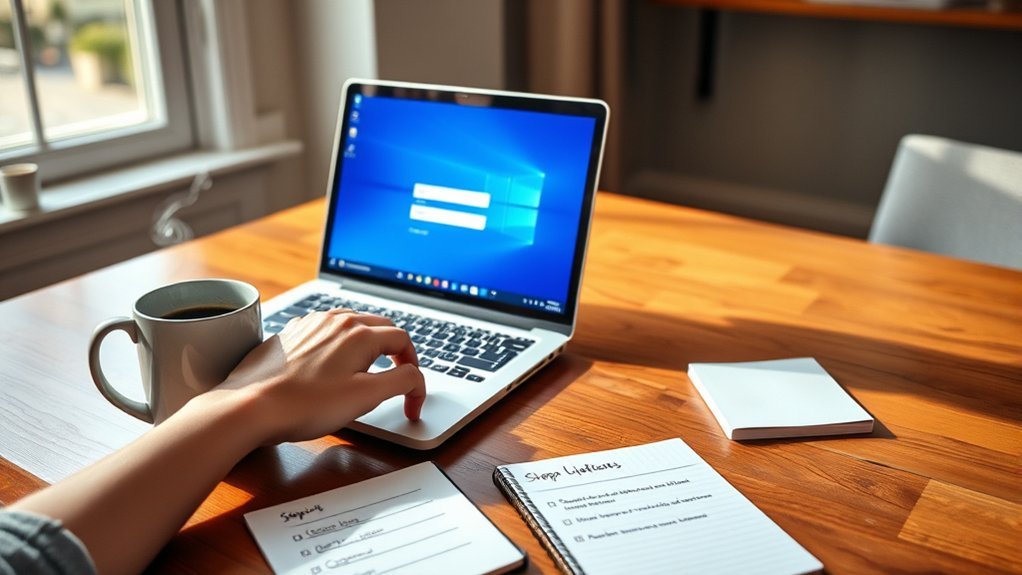Many believe creating a local account on Windows is a complicated task, but that’s not the case. You can set up a new account quickly in just three simple steps. By following a straightforward process, you’ll gain the ability to customize your settings and manage user permissions seamlessly. Curious about how to get started? Let’s break it down step by step.
Accessing the Settings Menu
How do you access the Settings menu on your Windows device? It’s simple! Start by clicking the Start button, usually located at the bottom left corner of your screen.
You’ll see a gear icon that represents Settings; click on that. Alternatively, you can press the Windows key + I on your keyboard as a shortcut to open the Settings menu directly.
Once you’re in, you’ll find various options to customize your device, control privacy settings, and manage user accounts.
Explore a range of options to personalize your device, safeguard your privacy, and manage user accounts seamlessly.
Steering through this menu empowers you to optimize your system according to your needs. With just a few clicks, you’re on your way to taking control of your Windows experience and enhancing your productivity.
Adding a New User Account
To add a new user account on your Windows device, navigate back to the Settings menu you just accessed. Follow these simple steps:
- Click on “Accounts” from the menu options.
- Select “Family & other users” on the left sidebar.
- Under “Other users,” click “Add someone else to this PC.”
You’ll be prompted to enter the new user’s information. If you prefer a local account, choose “I don’t have this person’s sign-in information,” then “Add a user without a Microsoft account.”
Complete the required fields, and you’ll create a new local account. This gives you the freedom to personalize your Windows experience while ensuring your privacy and control over your device.
Enjoy the liberation of your own space!
Customizing Your Local Account Settings
After creating your local account, you can start customizing its settings to better fit your needs.
First, access the Settings menu by clicking on the Start button and selecting the gear icon. From there, choose “Accounts” to adjust your profile details, such as your display name and password.
Access the Settings menu via the Start button and gear icon to update your profile details like display name and password.
You can also manage privacy settings, allowing you to control what information apps can access. If you want to personalize your experience further, explore the “Personalization” section for options like background, colors, and themes.
Don’t forget to set up your preferred security options, like a password or PIN, to keep your account safe. Customizing these settings empowers you to create a more enjoyable and secure computing environment.
Frequently Asked Questions
Can I Create a Local Account Without an Internet Connection?
Yes, you can create a local account without an internet connection. Just choose the option for offline account during setup, and follow the prompts. You’ll have full control without relying on external networks.
How Do I Switch Between Local and Microsoft Accounts?
To switch between accounts, go to Settings, select Accounts, then Your Info. Choose “Sign in with a local account” or “Sign in with a Microsoft account.” Follow the prompts to complete the switch.
What if I Forget My Local Account Password?
If you forget your local account password, you can reset it using a password reset disk, or by accessing Safe Mode. Alternatively, you might need to reinstall Windows to regain access to your files.
Can I Delete a Local Account Later?
Sure, you can delete a local account anytime! It’s not like a dramatic breakup; just a few clicks and poof! Your account’s gone, freeing you from the clutter. Enjoy that newfound liberation!
Are Local Accounts More Secure Than Microsoft Accounts?
Local accounts can be more secure than Microsoft accounts, as they minimize online exposure and reliance on cloud services. However, they lack certain features, like syncing across devices, which you might find convenient.
Conclusion
Now that you know how to create a local account on Windows, you might wonder if it’s really necessary in today’s online world. While some believe online accounts are more convenient, local accounts provide enhanced privacy and control over your data. They’re perfect for users who prefer to keep their information offline. So, whether you want added security or just like the simplicity of a local setup, following these steps will get you started easily.

